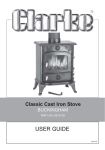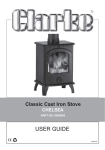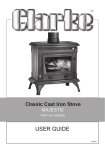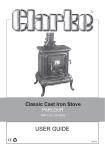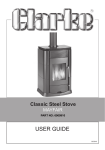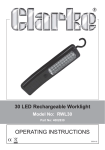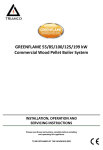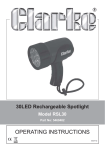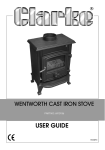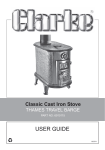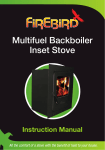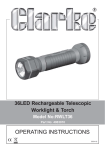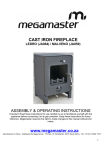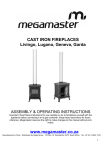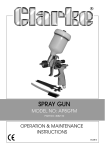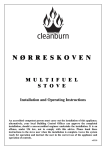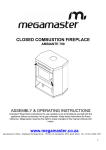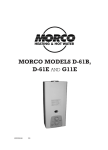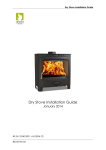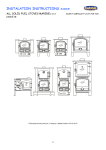Download USER GUIDE - Machine Mart
Transcript
Classic Cast Iron Stove REGAL II PART NO: 6910131 USER GUIDE GC11/11 INTRODUCTION Thank you for purchasing this CLARKE Classic Cast Iron Stove. Before attempting to install or use the stove, please read this manual throughout and follow the instructions carefully. Thoroughly familiarise yourself with this stove & it’s operation in order to ensure the safety of yourself and others around you. Henceforth, you can look forward to the stove giving you long and satisfactory service. GUARANTEE This product is guaranteed against faulty manufacture for a period of 12 months from the date of purchase. Please keep your receipt which will be required as proof of purchase. This guarantee is invalid if the product is found to have been abused or tampered with in any way, or not used for it’s intended purpose. Faulty goods should be returned to their place of purchase, no product can be returned to us without prior permission. This guarantee does not effect your statutory rights. PRODUCT SPECIFICATION REGAL II Part Number 6910131 Weight 91 kg Dimensions (W x H x L) 519 x 580 x 360mm Flue Size 146 mm o/d Efficiency 77 % Fuel Wood/Coal Nominal Heat Output 6.8 kw (23,215 BTU) Space Heating Output 6.8 kw (23,215 BTU) Gas Mass Flow 0.61 g/s Operation Intermittent Please note that details and specifications contained herein, are correct at the time of going to print. All data is applicable to wood burning use only. CLARKE International reserve the right to change specifications at any time without prior notice. 2 Parts & Service: 020 8988 7400/E-mail:[email protected] or [email protected] INSTALLATION OF THIS PRODUCT WARNING! AN ACCREDITED HEATING ENGINEER MUST CARRY OUT THE INSTALLATION OF THIS STOVE. ALTERNATIVELY, SHOULD A NONACCREDITED ENGINEER UNDERTAKE THE INSTALLATION, YOUR LOCAL BUILDING CONTROL OFFICER WILL BE REQUIRED TO APPROVE THE COMPLETED INSTALLATION UNDER BUILDING REGULATION “J”. IT IS AN OFFENCE UNDER UK LAW, NOT TO COMPLY WITH THIS MANDATORY REQUIREMENT. IF THE STOVE IS NOT FITTED CORRECTLY BY AN APPROVED PERSON, IT COULD RESULT IN A HOUSE FIRE OR CARBON MONOXIDE POISONING. READ ALL THE INSTRUCTIONS CAREFULLY BEFORE INSTALLATION The instructions cover the basic principles to ensure satisfactory installation of the stove, although detail may need slight modification to suit particular site conditions. In all cases the installation must comply with current building regulations, ‘HMG Approved Document J’, local authority bye-laws, European and National standards and any other specifications or regulations as they affect the installation of the stove. The information contained in this manual includes extracts from the Building Regulations 2000 ‘HMG Approved Document J’ (Combustion Appliances and Fuel Storage Systems), updated October 2010. This guidance information in no way replaces your responsibility as an installer or end user to comply with the appropriate standards. SAFETY WARNINGS FOR YOUR GUIDANCE THIS STOVE WILL BE HOT when in operation and due care should be taken. Thick gloves should be used to operate the primary/ secondary controls or reaching inside the stove to position fuel or remove ash. FIRES CAN BE DANGEROUS - Always use a fireguard in the presence of children, the elderly or the infirm. The fireguard should be manufactured in accordance with B.S. 6539 - Fireguards for use with solid fuel appliances. DO NOT OVERFIRE - it is possible to fire the stove beyond its design capacity. This could damage the stove, so watch for signs of over-firing - if any part of the stove starts to glow red, the stove is in an over-fire situation and the controls should be adjusted accordingly. Never leave the stove unattended for long periods without first adjusting the controls to a safe setting. Careful air supply control should be exercised at all times. 3 Parts & Service: 020 8988 7400/E-mail:[email protected] or [email protected] THIS STOVE MUST BE CONNECTED TO A SUITABLE FLUE OUTLET. Due to high temperature this stove should be located well away from furniture and curtains. Children and adults should be alerted to the hazards of hot surfaces. Young children should be carefully supervised when they are in the same room as the stove. Do not place clothing or other flammable material on or near the stove. Keep the stove area clear of combustible materials, flammable liquids or vapours. CARBON MONOXIDE POISONING CAN BE FATAL. Carbon Monoxide detectors to BS EN 50291 are available for use in domestic premises and details are available in the official HETAS guide that can be viewed on their website at www.hetas.co.uk. Due consideration should be given to the dangers of carbon monoxide poisoning following incomplete combustion of solid fuels in an enclosed space. See page 15 in this booklet. GENERAL SAFETY RULES 1. ALWAYS read and understand the manual before installing and commissioning the stove. 2. ALWAYS ensure the stove is installed in accordance with local regulations. 3. ALWAYS ensure that the stove is correctly installed and positioned as described under POSITIONING AND INSTALLATION on page 7, and that the immediate area is kept clear. 4. ALWAYS check for damage before using the stove. Check for breakage of parts and any other condition that may affect the stoves performance. Any damage should be properly repaired or the part replaced. If in doubt, DO NOT use the stove. Consult your local dealer. 5. ALWAYS keep children and visitors at a safe distance from the stove. 6. NEVER direct any kind of liquid on to the stove, particularly when it is hot. 7. NEVER use gasolene or other flammable liquids for fire starting. 8. NEVER use the stove to burn materials other than recommended fuels. 9. NEVER carry out any modifications to this product. If experiencing difficulty of any kind consult your local dealer. 10. The installation of the stove and chimney MUST comply with all National, European and local building regulations. It is the responsibility of the owner and the installer to ensure that the installation complies. 11. All rooms where a stove is situated must have a non-motorised air vent. Refer to details contained in the Building Regulations. 12. Building Regulation “J” is the Government approved document covering the installation of solid fuel stoves. 4 Parts & Service: 020 8988 7400/E-mail:[email protected] or [email protected] UNPACKING & ASSEMBLY UNPACKING Before assembling, please check contents against the following list of loose items and advise your dealer immediately if any parts are missing. Refer also to parts list & diagram on pages 24 & 25. 4 x Legs 1 x Ash-pan & Handle 1 x Flue Collar 1 x Fixings Kit (nuts, bolts, washers, Fire Cement & 2 x hex keys) TOOLS REQUIRED 13mm spanner (foot bolts) 10mm spanner (baffle assembly bolts and blanking plate nuts) Small hex Key (supplied) - window glass retainers Large hex key (supplied) - flue collar & blanking plate A full range of flue pipes and fire cement is available from your Clarke dealer. WARNING: DUE TO THE WEIGHT OF THE STOVE IT IS RECOMMENDED THAT TWO PEOPLE PERFORM THE UNPACKING AND ASSEMBLY. Unpack the stove and remove packing materials. Open the doors and remove the legs, flue collar and fixings kit from inside the stove. FIG 1 1. Place the stove on a soft surface such as the polystyrene packing materials from the crate and tilt the stove back. 2. Attach the legs using the bolts and washers supplied as shown in Fig 1 before standing the stove upright. 3. If the stove is to be connected to a vertical chimney above, attach the flue adaptor as shown in Fig 2 overleaf, 5 Parts & Service: 020 8988 7400/E-mail:[email protected] or [email protected] using the socket head bolts, nuts & washers supplied and tighten with the key provided. Ensure the fireproof gasket is correctly seated in the base of the flue adaptor. Fig 2 4. Check that the blanking plate is fitted in the rear panel when the vertical flue exit is required. 5. If the rear mounting flue configuration is to be used, the blanking plate will be fitted to the top of the stove and the flue connector to the rear panel. Fig 3 To do this, the rear baffle will need to be removed from inside the stove to gain access to the rear flue fastenings. Baffle Assembly 6. Lift out the log retainer bar and the two side firebrick panels shown in Fig 3. Lift out the removable baffle and remove the four bolts holding the fixed baffle assembly to the back of the stove. Remove the baffle. Side Firebrick Removable Baffle Log Retainer Clamp Bar • You can now access the rear blanking plate. Hex socket screw 7. Using the hex key provided, undo the screw securing the blanking plate clamp shown in Fig 4 and remove the blanking plate and clamp. Fig 4 8. The blanking plate can now be fitted to the top of the stove and the flue adaptor to the rear as in Fig 5. Fig 5 9. Replace all the components removed above and ensure the ashpan is in position below the grate. A handle is supplied for when the stove is in use. 10. Place the stove in the desired location as shown in POSITIONING AND INSTALLATION. Take care not to damage the floor surface. 6 Parts & Service: 020 8988 7400/E-mail:[email protected] or [email protected] POSITIONING AND INSTALLATION In England and Wales, there are only two routes to legally install a domestic solid fuel or wood burning appliance. In other parts of the UK there are variations in legislation and processes. You can either: • Use a registered installer who can self certify that the work he does complies with the relevant Building Regulations; or • The consumer applies to their local authority building control department for a building notice, and pays the appropriate fee. It is generally worthwhile to use a HETAS registered installer who will supply a Certificate of Compliance as a record of the job and that it complies with Building Regulations. A copy of the certificate is forwarded to HETAS who notify the local authority on your behalf. Failure to notify the work through the registration scheme (in this case HETAS) or directly to the local authority can lead to enforcement. It can also cause problems for future house sales if there is no official record of a compliant installation. All local regulations, including those referring to National and European Standards need to be complied with when installing this appliance. SUPPORTING FLOORS The stove must only be installed on floors with an adequate load bearing capacity and if the existing construction is not suitable, additional measures such as a load distributing plate must be provided. The hearth should be able to accommodate the weight of the stove and its chimney if the chimney is not independently supported. Stoves should stand wholly above hearths made of non-combustible board/sheet material or tiles at least 12mm thick, if the stove is not to stand in a recess (and has been tested to an applicable standard to verify that it cannot cause the temperature of the upper surface of the hearth to exceed 100°C). Constructional hearths should be made of solid, non-combustible material such as concrete or masonry, at least 125mm thick, including the thickness of any non-combustible floor and/or decorative surface. Specific guidance for surfaces on which the stove may be allowed to stand is given in ‘HMG Approved Document J’ and must be followed. When the stove is positioned near a wall constructed of flammable material, the distances shown on Fig 6 must be adhered to. Alternatively, a heat shield may be used, mounted according to the position of the fireplace. A firewall must be at least 100 mm thick and typically made of brick, or concrete/ stone. 7 Parts & Service: 020 8988 7400/E-mail:[email protected] or [email protected] MATERIAL CLEARANCES The stove must have a minimum clearance of 1200 mm to a combustible ceiling below. Fig 6 It is recommended that the stove be installed at least 800 mm from combustible materials. However, any household furnishings should be at least 1000 mm away as they could be adversely affected by heat. The stove can be recessed in a suitable sized fireplace but a permanent free air gap of at least 200mm must be left around the sides and top and at least 50mm at the back of the stove to obtain maximum heat output and for access to the rear of the stove. MINIMUM DISTANCE TO COMBUSTIBLE MATERIALS Note: combustible material refers to any material that will degrade when subjected to heat e.g. plaster. Due to the heat of a hot stove, a suitable fire guard should always be used to provide additional protection. Never allow young children to be left unsupervised in a room containing a hot stove. If in doubt, refer to Building Regulations 2000 (HM Approved Document “J”). THE CHIMNEY The stove is supplied with a flue pipe connector for top or rear mounting but should never be connected to a shared chimney/flue system. If there is no existing chimney, then a prefabricated block chimney in accordance with Building Regulations HMG Approved Document J, or a twinwalled insulated stainless steel flue to B.S.4543 can be used. These chimneys must be fitted in accordance with the manufacturer’s instructions and the appropriate building regulations. 8 Parts & Service: 020 8988 7400/E-mail:[email protected] or [email protected] Flue pipes with a smaller cross-sectional area than that of the stove outlet should never be used. Flue pipes must not project into the chimney connector, such as to cause a restriction to the gas flow. Sizes of flues in chimneys are stipulated in Table 2 of the Building Regulations 2000 HMG Approved Document “J” as follows: 1. Stoves under 20kW rated output which burn smokeless or low volatile fuel require a minimum flue size of 125mm diameter (or rectangular flues having the same cross-sectional area and a minimum dimension not less than 100mm for straight flues or 125mm for flues with bends or offsets. 2. Stoves of up to 30kW rated output burning any fuel require 150mm diameter (or rectangular flues having the same cross-sectional area and a minimum dimension not less than 125mm. Liners should be installed in accordance with their manufacturers instructions. Appropriate components should be selected to form the flue without cutting and to keep joints to a minimum. Bends and offsets should be formed only with the matching factory-made components. Liners need to be placed with the sockets or rebate ends uppermost to contain moisture and other condensates in the flue. Joints should be sealed with fire cement, refractory mortar or installed in accordance with their manufacturers instructions. Ensure the joints are completely sealed as air leakage will lead to poor performance. Avoid having more than two bends in the flue system. Any offset between bends should be minimised and the flue should be equipped with suitable access doors for inspection & cleaning. For further detail refer to Building Regulations document “J” A range of suitable flue pipes, cowls and fire cement are available from your Clarke dealer. Special methods are required when passing through a wall or ceiling. Please refer to your local building regulations and/or fire department. Refer to Building Regulations Document “J”. THIS STOVE MUST NOT BE INSTALLED INTO A CHIMNEY THAT SERVES ANY OTHER HEATING APPLIANCE. THERE MUST NOT BE AN EXTRACTOR FAN FITTED IN THE SAME ROOM AS THE STOVE, AS THIS CAN CAUSE THE STOVE TO EMIT FUMES INTO THE ROOM. FLUE HEIGHT The chimney height and the position of the chimney should conform to the Building Regulations document “J”. Flues should be high enough to clear the products of combustion. The height necessary for this will depend on the type of the appliance, the height of the building, the type of flue and the number of bends in it, and an assessment of local wind patterns. However, a minimum flue height of 4.5m could be satisfactory if the guidance in paragraphs 2.10 to 2.12 of the Approved Document “J” is adopted. 9 Parts & Service: 020 8988 7400/E-mail:[email protected] or [email protected] Fig 7 As an alternative approach, the calculation procedure within BS EN 133841:2005 can be used as the basis for deciding whether a chimney design will provide sufficient draught. If in doubt, consult the Building Regulations. The outlet from a flue should be above the roof of the building in a position where the products of combustion can discharge freely and will not present a fire hazard, whatever the wind conditions. External flue pipes should be Twin Wall. These retain the heat, enabling it to rise and disperse from the chimney. BENDS IN FLUES Openings for inspection & cleaning should be formed using purpose factorymade components compatible with the flue system, having an access cover that has the same level of gas-tightness as the flue system and an equal level of thermal insulation. Offsets in flues are only acceptable if the following rules are respected: a) The chimney system shall have no more than 4 bends in total; - 2 bends in the chimney and 2 bends in the flue pipe connection. b) The offset shall provide a change of direction no more than 45 degrees from the vertical. 10 Parts & Service: 020 8988 7400/E-mail:[email protected] or [email protected] c) The run of the chimney between bends shall not exceed 20% of the total chimney length. d) Maximum length of horizontal flue must not exceed 150mm (6”). INSPECTION & CLEANING Check that the chimney is in good condition, dry and free from cracks and obstructions. If any of these requirements are not met, the chimney should be lined by a suitable method. The chimney must be swept before connection to the stove. Where the chimney is believed to have previously served an open fire installation, it is possible that the higher flue gas temperature from the stove may loosen deposits that were previously firmly adhered, with the consequent risk of flue blockage. It is therefore recommended that the chimney be swept a second time within a month of regular use after installation. Assuming that when the stove is first installed, the chimney is clean, and sound, then the chimney flue should be inspected part way through the burning season to establish the regularity of sweeping required. If you have any doubts about the suitability of your chimney, consult your local dealer/ stockist. FLUE DRAUGHT A flue draught of minimum 1.2mm to a maximum 2.5mm ‘water gauge’ is required for satisfactory stove performance. The flue draught should be checked under fire at high output. If it exceeds the recommended maximum, a draught stabiliser must be fitted so that the rate of burning can be controlled to prevent over-firing. If the reading is less than the recommended minimum, then the performance of the stove will be compromised. AIR FOR COMBUSTION Any room or space containing a stove should have a permanent air vent opening of at least the sizes shown in the table below. For stoves designed to burn a range of different solid fuels, the air supply should be designed to accommodate burning the fuel that produces the highest heating output. There must always be a permanent means of providing air for combustion into the room in which the fire is installed. A permanent vent with a total free area of at least 550mm2 for every kW rated above 5kW should be connected directly to the outside air or an adjacent room which itself has a permanent vent of the same size direct to the outside air. The fitting of an extractor fan to either of these rooms is not permitted. 11 Parts & Service: 020 8988 7400/E-mail:[email protected] or [email protected] Stove Air Supplies Permanently open vents as below: Stove with flue draught stabiliser If design air permeability>5.0m3/(h.m2) then 300mm2/kW for first 5kW of appliance rated output 850mm2/kW for balance of appliance rated output If design air permeability<5.0m3/(h.m2) then 850mm2/kW for balance of appliance rated output Permanently open vents as below: Stove with no flue draught stabiliser If design air permeability>5.0m3/(h.m2) then 550mm2/kW of appliance rated output above 5kW If design air permeability<5.0m3/(h.m2) then 550mm2/kW for balance of appliance rated output CONNECTION TO THE CHIMNEY This MUST be carried out by an accredited/competent person and/or approved by your local Building Control Officer before using the stove. Any existing flue must be in good condition with suitable access for collection and removal of debris. Details of suitable linings for use with solid fuel are given in the official HETAS guide that can be viewed on their website at www.hetas.co.uk It is also important that suitable flue pipe complying with Building Regulations is used to connect the stove to the chimney flue and that suitable access is provided into the flue for regular inspection and sweeping of the flueways. Chimneys should be as straight as possible. Horizontal runs should be avoided except where the rear outlet of the appliance is used, in which case, the horizontal section should not exceed 150mm (6 inches) in length. Refer to the typical installation diagrams, Fig 8-11. Flue connections must be well sealed. There are several ways of connecting the stove to the flue as shown in Figures 8-11. If the vertical rear flue is used, the chimney may be swept through the appliance. If it is not possible to pass the sweeps brush through the stove, a soot door will be necessary. This may be either in the actual brickwork of the chimney or fitted in the register plate. Various suitable positions of soot doors are shown in Figures 8-11. 12 Parts & Service: 020 8988 7400/E-mail:[email protected] or [email protected] Fig 8: Vertical register plate with bricked up fireplace. Fig 9: Horizontal register plate with top flue connection Fig 10: Horizontal register plate with rear flue connection. Fig 11: Horizontal register plate with optional vertical rear flue connection. 13 Parts & Service: 020 8988 7400/E-mail:[email protected] or [email protected] A non-combustible register plate minimum 1.5 mm thick should be fitted to all installations between the flue and the building structure. It’s suitability and fit should be checked by a qualified stove installation engineer against the current Building Regulations “J”. Fig 12 CLEANING THE FLUE Access for cleaning the flue should be incorporated in the system other than through the appliance (e.g. a soot door or access through a register plate). Purpose-made soot doors and inspection lengths are available from the Clarke range. Ensure that the whole length of the flue can be reached from the soot door. FUME EMISSIONS To avoid chimney problems, your fire should not be burnt slowly for longer than 12 hours without a period of fast burning. Properly installed and operated, this stove will not emit fumes. Occasional fumes from de-ashing and refuelling may occur. Persistent fume emission must not be tolerated. If fume emission persists, the following immediate action should be taken:1. Open doors and windows to ventilate room. 2. Let the fire out, or eject and safely dispose of fuel from the stove. 3. Check for flue chimney blockage and clean if required. 4. Do not attempt to re-light the fire until the cause has been identified and corrected. If necessary, seek professional advice. Important! Never fit an extractor fan in the same room as this stove. 14 Parts & Service: 020 8988 7400/E-mail:[email protected] or [email protected] CARBON MONOXIDE ALARMS Due consideration should be given to the dangers of carbon monoxide poisoning following incomplete combustion of solid fuels in an enclosed space. Carbon monoxide detectors to BS EN 50291 are available for use in domestic premises and details are available in the official HETAS guide that can be viewed on their website at www.hetas.co.uk. Where a new or replacement fixed solid fuel appliance is installed in a dwelling, a carbon monoxide alarm should be provided in the room where the appliance is located. Carbon monoxide alarms should comply with BS EN 50291:2001 and be powered by a battery, designed to operate for the working life of the alarm. The alarm should incorporate a warning device to alert users when the working life of the alarm is due to pass. Mains-powered BS EN 50291 Type A carbon monoxide alarms with fixed wiring (not plug-in types) may be used as alternative applications, provided they are fitted with a sensor failure warning device. The carbon monoxide alarm should be located in the same room as the appliance: a. On the ceiling at least 300mm from any wall or, if located on a wall, as high up as possible (above any doors and windows) but not within 150mm of the ceiling and b. Between 1m and 3m horizontally from the appliance. Note: Further guidance on the installation of carbon monoxide alarms is available in BS EN 50292:2002 and from manufacturers instructions. Provision of an alarm should not be regarded as a substitute for correct installation and regular servicing. 15 Parts & Service: 020 8988 7400/E-mail:[email protected] or [email protected] USING YOUR STOVE THE CONTROLS The amount of heat emitted by the stove is regulated using the following air controls: A) The primary air supply is controlled using the two lower air controls built into the ashpan door. B) A second air inlet provides a constant, pre-heated air supply to the combustion just above the fire. This is controlled using the upper air control mounted near the top of the stove. This air supply will not normally need to be regulated so will usually be kept open. Fig 13 Upper Air Controls Grate Riddling Handle Updraught Control C) An additional air inlet is provided in the base of the stove. This is controlled using the knob at the bottom of the stove to provide a gentle updraught from the back of the stove to the chimney flue. D) The knob on the left is for riddling (moving) the grate panel to dislodge any accumulation of loose ash into the ash pan. WARNING: THE TEMPERATURE REACHED BY THESE ITEMS DURING OPERATION MAY CAUSE AN INJURY TO AN END-USER. AS THESE ARE INTENDED TO BE ADJUSTED DURING OPERATION, IT IS RECOMMENDED THAT PROTECTIVE GLOVES ARE WORN WHEN HANDING THESE PARTS. TYPES OF FUEL This stove will function with wood or coal, but in general all fuel should be dry and timber should be well seasoned so as to have a moisture content below 20%. The use of damp wood will result in more soot and tar deposits being left in the chimney, flu and stove, and will not release heat if thermal energy is being used to drive out moisture from the fuel. Other fuels can be used together with wood, provided the base of the fire remains as wood or compressed block fuels. Coal products can be added to 16 Parts & Service: 020 8988 7400/E-mail:[email protected] or [email protected] this provided the volume of coal products is less than that of other fuels. With solid fuels, there is less need to burn the stove hard after refuelling. The rate of refuelling will also be less often than with wood. Avoid using the stove to incinerate other materials including household waste. Avoid using ‘green’ unseasoned wood, treated wood such as telegraph poles, or plywood / chipboard containing glues and resins which pollute the environment and cause the fire to burn too quickly. Such materials can produce excessive tar or creosote which can be damaging and in extreme cases cause a fire inside the chimney. The dryness of wood can be assessed by looking at the end of the log. Radial cracks, deep enough to be considered as splits should be present in dry, seasoned logs. The maximum length of fuel suitable for this stove is approx. 30 cm so as to lay flat over the embers, and logs of greater than 10 cm diameter should be split. Confirm with your fuel provider as to which type will suit best. Larger fuels will allow a greater draught in the firebox which will speed up combustion. Household coal produces more ash & chimney deposits than smokeless fuels. For further information on type and availability of fuel, the Solid Fuel Association (http:/www.solidfuel.co.uk) serves as an advice centre to domestic consumers including all aspects of fuel types. The UK Smoke Control Areas website (http:/www.uksmokecontrolareas.co.uk) defines the location of smoke controlled areas throughout England, Scotland, Wales and Northern Ireland and lists all fuels which are authorised for use in Smoke Control Areas. However, you should check with your local council to confirm that you can use a stove in a smoke controlled area. INITIAL SEASONING Following installation, and before regular use, the stove must be seasoned to prevent cracking of the metal casting. This procedure should also be followed if the stove has not been used for prolonged periods (during the summer months for example), and is carried out as follows: 1. Light a small fire in the middle of the stove, well away from the sides. 2. Allow the stove to warm up slowly and evenly with the air controls almost closed, avoiding intense flames. 3. Keep the fire burning for three hours or so, gradually increasing the size of the fire using larger logs which will burn naturally but slowly, keeping the stove on a low setting. 4. After a couple of days burning at this level, increase the brightness & intensity of the fire gradually over the next 10 days. Full strength fires should not be used until completion of approx. 20 days of mild use. Only from this time will the stove have been properly seasoned. 17 Parts & Service: 020 8988 7400/E-mail:[email protected] or [email protected] It should be remembered that this procedure should be carried out at the beginning of each season of use in order to remove the moisture retained by the metal during the period of non-use. When used for the first time the fireplace may smell a little, due to gas being given off. The gas is not toxic but the room should be thoroughly ventilated. Let the fire burn with a high draught until no smells can be detected. Take care not to open the stove doors too vigorously in case of causing smoke spillage. If smoke spillage occurs after the fire door has been opened this could be due to poor chimney draft. See TROUBLESHOOTING. FIRE-LIGHTING WITH WOOD 1. Open the air controls. 2. Lay firelighters or rolled up newspapers on the grate with a reasonable quantity of dry kindling wood. Place two or three small logs on top. 3. Light the newspaper or firelighters using a long taper and close the door. 4. When the fire is burning strongly, add further logs up to 10mm diameter. 5. When the stove is really hot, close the front air control as required. Ensure there are lasting flames until the wood becomes charcoal. FIRE-LIGHTING WITH SOLID FUEL 1. Open the air controls. 2. Lay firelighters or rolled up newspapers in the stove with a reasonable quantity of dry kindling wood. Place a small quantity of solid fuel on top. 3. Light the newspaper or firelighters using a long taper and close the door. 4. When the fire is burning strongly, add further fuel. 5. When the stove is hot, reduce the opening of the air controls. 6. The burn rate can be reduced by partially closing the air controls or damper. REFUELLING 1. Always open the doors slowly to avoid a sudden rush of intake air and smoke escaping into the room and add fuel. 2. Open the air controls and leave open for a few minutes to allow the gasses in the wood to burn before closing the air controls. • The rate of refuelling and heat available are dependant upon individual requirements based upon the user’s experience. When re-loading, it is normally necessary to burn the stove fast initially, to drive off any gasses and moisture, before closing the air vents to control the burn rate. • Ensure the doors are kept closed to contain fumes except when lighting up, re-fuelling or removing ash. 18 Parts & Service: 020 8988 7400/E-mail:[email protected] or [email protected] • It is not recommended to leave the stove alight at night or to continue using the stove in mild weather which gives poor combustion leading to a greater buildup of soot. • If overnight burning is required, it can best be achieved by first driving off any gasses or moisture as usual, following a full charge of fuel and then closing the air vents fully. Experience will indicate the optimum setting. However, by reducing the burn rate to such a level that the fire is still burning the following day, the burning process creates heavy, tarry chemicals which will become deposited on the inside of the flue or chimney. This is an inefficient process which greatly increases the risk of a chimney fire and makes it necessary to sweep the chimney more often. ASH REMOVAL Keep the stove free from a heavy buildup of ash. The frequency of this is dependant upon the type and quality of fuel being used. Ash should be removed before it builds up to the underside of the grate, at which point, the grate would be burning hot on both sides, shortening its life expectancy. When disposing of ashes, ensure they have cooled and always place in a metal container. Be sure to remove the ash when the fire is at its lowest point, such as first thing in the morning. The Ash Can Filter is ideal for use in conjunction with the Clarke range of vacuum cleaners, for collecting hot ash and debris from stoves. ACCESSORIES Refer to the Clarke website www.clarkeinternational.com for a full range of Flue Pipes & Cowls for use with this classic cast iron stove. See also the following accessories; Fire Cement (1Kg tubs) Part No: 6910000 Heat Resistant Stove Paint Part No: 6910200 Ash Can Filter Part No: 6471130 Paper Briquette Maker Part No: 1801617 5-Piece Black Companion Set Part No: 6912130 Electric Log Splitters; Log Buster 5 Part No: 3402030 (see also Logbusters 4, 6 & 7) 19 Parts & Service: 020 8988 7400/E-mail:[email protected] or [email protected] TROUBLESHOOTING PROBLEM CAUSE SOLUTION Fire difficult to start. Wood green, too damp or poor quality. Use recommended fuel. Logs are too large. When lighting, use small, dry kindling. To maintain the fire use split logs. Air starvation. Open upper and lower air controls. Insufficient draught. Check that flue is not obstructed, sweep flue if necessary. Too much draught. Ensure that the lower air control is closed. Partially close the top air control Excessive draw. Install a draught stabiliser. Consult your dealer. Poor quality wood. Do not continuously burn small wood, sticks, carpentry offcuts, plywood etc. Flue duct is cold. Burn paper and kindling wood to increase heat. Room is at negative air pressure to the outside. In houses equipped with mechanical ventilation, open a window until the fire is well established. Low heat output. Incorrect fuels. Use recommended fuels. Smokes while burning. Draught is insufficient. Consult a chimney specialist. Check that flue is not obstructed. Sweep if necessary. Downdraught present. Install an anti-downdraught cowl. Consult your dealer. Room is at negative pressure to outside. In houses equipped with mechanical ventilation, an outside air intake must be installed in the chimney. Chimney not tall enough to be clear of roof line. Increase height of chimney. Poor sealing of flue-pipe joints. Re-connect flue or replace jointing material. Flue is partially blocked with soot. Arrange to have chimney swept. House too tightly sealed. Ensure a fresh air supply is reaching the stove. Fire goes out. Fire burns too quickly. Stove smokes when lighting up. Smoke spillage when opening door. 20 Parts & Service: 020 8988 7400/E-mail:[email protected] or [email protected] MAINTENANCE CLEANING The inside of the stove may require regular cleaning, especially during periods of peak use, the frequency of this being indicated by experience. It is advisable to wear a dust mask, protective gloves and safety glasses when cleaning. Use a stiff brush and industrial type vacuum cleaner to dislodge and remove as much material as possible, starting at the top of the stove and working down to the bottom. Particular attention should be given to the air inlet controls which can become obstructed. A CVAC Ash Can Filter and vacuum cleaner is ideal for this process. GENERAL MAINTENANCE Take this opportunity to check for any damaged parts inside the stove. In the event of damage or broken components, replacements can be obtained from Clarke Parts & Service. On no account should unauthorised spare parts be used. The stove and flueway should be inspected and maintained when in a cold condition. NO unauthorised modification of this product should be carried out. This stove requires regular maintenance by a competent engineer. STOVE BODY The stove is finished with a heat-resistant paint which can be cleaned with a soft brush. Wait until the stove has cooled down before doing this. This finish can be renovated with Clarke stove paint, although the paint may not be an exact match and it may be necessary to repaint the complete stove. If the stove is purely ornamental, painting will provide a durable, attractive finish. If the stove is used for heating, a high temperature heat resistant paint (available from your Clarke dealer) must be used, in either aerosol or brush applied form. Should rust become apparent, clean thoroughly with a wire brush and apply a suitable anti-rust treatment. During prolonged periods out of use, the air inlets should be left open and the door left slightly ajar in order to circulate fresh air and discourage condensation from forming which could encourage corrosion. FIRE ROPE Check the rope around the door and glass. If rope is becoming detached, replace with rope approved for this purpose. Inspect the fireproof door seals where fitted, to ensure there is an effective seal around the door and re-fix it if loose using stove rope adhesive. If in poor condition it should be replaced. 21 Parts & Service: 020 8988 7400/E-mail:[email protected] or [email protected] GLASS PANELS Clean any glass panels when cool, avoiding abrasive substances which could scratch the glass and make subsequent cleaning more difficult. Wet logs against a heated glass, a badly aimed poker or heavy slamming of the doors could crack the glass panels. The glass will not fracture with heat. Never replace any broken glass with glass NOT approved for use with cast iron stoves. The window glass should remain clean during normal use but it can become blackened if the stove is being operated with either damp fuels or at a slow burn rate. The blackening may be dispersed by burning briefly at a much higher temperature, or it may be cleaned off using specialist glass cleaner. In the event of the glass being broken, it can be removed by unscrewing the retaining clips using the hex key provided, taking care not to damage the fireproof seal. The replacement glass should be carefully placed against the seal and the retaining clips re-tensioned. Take care to tension these evenly or there is a risk of breaking the new glass pane. CHIMNEYS AND FLU-WAYS It is important that the chimney, flu-ways and any connecting flue pipe are swept regularly. This means at least once a year for smokeless fuels and at least twice a year for wood and other fuels. Only wire-centred sweep’s brushes fitted with a guide wheel should be used. If it is not possible to sweep all parts of the chimney through the stove, ensure there is adequate access to cleaning doors. If the stove is fitted in place of an open fire, then the chimney should be swept one month after installation to clear any soot falls which may have occurred, due to the difference in combustion performance between the stove and the open fire. The flue and chimney should be inspected for a buildup of deposits especially following prolonged periods without use. The entire chimney/flue should be swept frequently from top to bottom by a registered chimney sweep to remove any buildup of soot etc, the frequency being dependant upon the usage and the fuels being burnt. If the chimney is swept after a few weeks of regular use, the condition found will give an indication of the frequency of sweeping required. On an annual basis, the chimney is best swept just before the main winter burning season. HETAS recommends that chimney sweeping is best carried out by an approved chimney sweep who will normally be a member of the National Association of Chimney Sweeps or the Guild of Master Sweeps, details of which can be found on the HETAS website, www.hetas.co.uk. 22 Parts & Service: 020 8988 7400/E-mail:[email protected] or [email protected] PARTS DIAGRAM IMPORTANT: The use of parts other than CLARKE replacement parts may result in safety hazards, decreased appliance performance and may invalidate your warranty. 23 Parts & Service: 020 8988 7400/E-mail:[email protected] or [email protected] COMPONENT PARTS LIST No Parts List No Parts List 1 Removable Baffle 26 Log Retainer Bar 2 Baffle Cover Assembly 27 Roundhead allen bolt 6 x 8mm 3 Baffle Base Assembly 28 Stainless Steel Knob 4 Grate Bracket 29 X-headed Bolt 8 x 35mm 5 Door Frame 30 Blanking Plate Clamp Bar 6 Leg (x 4) 31 Fire Rope gasket 8mm dia 7 Baseplate 32 Glass Securing Tab 8 Side Firebrick (state left or right) 33 Riddling Grate Rod 9 Sideplate (state left or right) 34 Riddling Grate Attachment 10 Ashpan 35 Ash Door Hinge Pin 11 Grate Baseplate 36 Rear Air Vent Operating Rod 12 Moving (Riddling) Grate 37 Rear Air Vent 13 Rear Firebrick Panel 38 Rear Air Vent Retainer 14 Flue Blanking Plate 39 Rear Air Vent Holding Bracket 15 Backplate 40 Wooden Door Handle 16 Flue Adaptor 41 Steel Handle Arm 17 Top Plate 42 Door Latch Tab 18 Ash Pan Handle 43 Retaining Nut 19 Ash Door 44 Hex hd Bolt 8 x 25mm 20 Front Plate 45 Washer 8 x 30mm 21 Air Inlet Cover 46 Air Wash Cover 22 Socket head bolt c/sunk 6x30 47 T-Handle 23 Glass Panel 48 Socket head Clamp Bar Screw 24 Fire Rope gasket 6mm dia 49 Baffle Bolt (Hex head) 25 Hinge Roll Pin If disposing of this product or any damaged components, do not dispose of with general waste. Metal products should be taken to your local civic amenity site for recycling of metal products. 24 Parts & Service: 020 8988 7400/E-mail:[email protected] or [email protected] DECLARATION OF CONFORMITY 25 Parts & Service: 020 8988 7400/E-mail:[email protected] or [email protected] NOTES ___________________________________________________________________________________ __________________________________________________________________________ __________________________________________________________________________ __________________________________________________________________________ __________________________________________________________________________ __________________________________________________________________________ __________________________________________________________________________ __________________________________________________________________________ __________________________________________________________________________ __________________________________________________________________________ __________________________________________________________________________ __________________________________________________________________________ __________________________________________________________________________ __________________________________________________________________________ __________________________________________________________________________ 26 Parts & Service: 020 8988 7400/E-mail:[email protected] or [email protected] NOTES ___________________________________________________________________________________ __________________________________________________________________________ __________________________________________________________________________ __________________________________________________________________________ __________________________________________________________________________ __________________________________________________________________________ __________________________________________________________________________ __________________________________________________________________________ __________________________________________________________________________ __________________________________________________________________________ __________________________________________________________________________ __________________________________________________________________________ __________________________________________________________________________ __________________________________________________________________________ __________________________________________________________________________ 27 Parts & Service: 020 8988 7400/E-mail:[email protected] or [email protected]




























